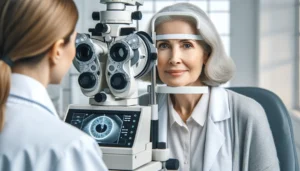The Vital Role of Flaxseed for Eye Health
Flaxseed for eye health emerges as a key ally in our daily quest to safeguard our vision. This modest seed, packed with omega-3 fatty acids, has gained attention for its potential to prevent and manage various eye conditions effectively. As we explore the scientific support behind flaxseed, we find compelling evidence that these nutrients are crucial in maintaining eye health and preventing diseases that can impair vision.
In this article, we’ll navigate through the benefits of incorporating flaxseed into your diet and how it can help maintain and even improve your eye health. With the rise of digital screen time and age-related visual deterioration, understanding and utilizing natural solutions like flaxseed can make a significant difference in enhancing and preserving your vision. Whether you’re looking to enrich your diet with health-promoting foods or seeking natural ways to support your eye health, flaxseed might just be the nutritional boost you need.
The Impact of Omega-3s on Eye Health: A Closer Look
DHA is a key structural component in the retina. It plays a vital role in maintaining the health of light-sensing cells, essential for vision. Studies show that adequate levels of DHA and EPA help preserve the retina’s integrity and function. This could prevent degenerative eye diseases in the future. These fatty acids also have anti-inflammatory properties. They can reduce symptoms of dry eyes, a common condition affecting millions worldwide.
How Omega-3 Fatty Acids Prevent Eye Diseases
Age-Related Macular Degeneration (AMD)
Omega-3 fatty acids, especially DHA and EPA, are linked to a lower risk of AMD. This is a major cause of vision loss in older adults. By adding flaxseed to your diet, you may help protect your eyes from this severe condition. The study “Protective effects of dietary carotenoids and omega-3 fatty acids on risk of age-related macular degeneration” shows a lower risk of AMD with higher omega-3 intake. Flaxseed is rich in ALA, which can be converted by the body into EPA and DHA to help prevent AMD.

Diabetic Retinopathy
High blood sugar can damage the retina in people with diabetes. Omega-3s protect these delicate structures and slow diabetic retinopathy’s progression. They play a key role in diabetic eye care.
A study “Omega-3 and omega-6 polyunsaturated fatty acids for dry eye disease” shows that omega-3s enhance retinal blood flow and vessel diameter. This could protect against vascular-related eye conditions, adding another benefit of omega-3-rich flaxseed.
In addition, the shows a slowdown in the progression of early diabetic retinopathy. This effect is due to their anti-inflammatory and neuroprotective properties, vital for those managing diabetes-related eye issues.
Dry Eye Syndrome
The anti-inflammatory effects of omega-3 fatty acids reduce dry eye symptoms. These include irritation and blurred vision. They improve the eye’s tear film. The 2022 scientific review “The effects of omega-3 fatty acids on dry eye disease” finds that omega-3s greatly improve symptoms and signs of dry eye. Their anti-inflammatory properties reduce irritation and enhance tear production. This makes flaxseed especially beneficial for those with dry eye.

Novel Omega-3 and Omega-6 Combination for Eye Health
A study on a novel omega-3 and omega-6 supplement shows effective improvement in dry eye and meibomian gland dysfunction. This emphasizes the need for a balanced fatty acid intake, achievable with flaxseed.
The Power of Flaxseed: A Rich Source of Omega-3 for Eye Health
Flaxseed stands out as an excellent source of omega-3 fatty acids, particularly alpha-linolenic acid (ALA). This plant-based nutrient is essential for those seeking a natural approach to maintain and improve eye health. Let’s explore why flaxseed is beneficial and how it contributes to eye wellness.
Nutritional Profile of Flaxseed
Flaxseed is not only rich in ALA but also contains lignans, fiber, and protein, making it highly nutritious. While ALA is an omega-3 fat that the body can convert into EPA and DHA, the conversion rate is generally low. However, even the small amount converted is sufficient to contribute to eye health, according to research.
Flaxseed vs. Other Omega-3 Sources
Compared to fish oils, which are direct sources of EPA and DHA, flaxseed provides ALA, which is a more sustainable and vegetarian-friendly option. For those who prefer plant-based diets or cannot consume fish due to allergies or other reasons, flaxseed offers a vital alternative.
Direct Benefits of Flaxseed for Eye Health
- Preventing Dry Eye Syndrome: The omega-3 ALA in flaxseed helps improve the function of the meibomian glands in the eyelids, which produce the oily part of tears. Adequate production of this oil is essential in preventing dry eyes.
- Reducing Risk of AMD: Regular consumption of flaxseed may help reduce the progression of age-related macular degeneration due to its omega-3 content. While it is not a direct substitute for fish oil, it still plays a significant role in a preventative diet.
- Supporting Retinal Health: ALA from flaxseed contributes to the structural integrity of the retinal cells. Although indirect, the benefit of maintaining cell health in the retina can’t be overstated, as it helps preserve vision.
Practical Tips on Incorporating Flaxseed into Your Diet
Integrating flaxseed into your daily routine can significantly enhance your intake of omega-3 fatty acids, which are essential for maintaining eye health. Here are some practical, easy ways to add flaxseed to your meals and ensure you are harnessing its full potential:
Start with Breakfast
- Smoothies: Add a tablespoon of ground flaxseed to your morning smoothie. It blends well with both fruit and vegetable smoothies, adding a nutty flavor without overpowering other ingredients.
- Oatmeal or Yogurt: Sprinkle ground flaxseed over your oatmeal or mix it into your yogurt. This not only boosts the omega-3 content but also increases the fiber and protein content of your breakfast.
Enhance Your Lunch and Dinner
- Salads: Toss a couple of teaspoons of ground flaxseed into your salads. It goes well with a variety of dressings and adds a subtle crunch.
- Soups and Stews: Mix flaxseed into soups and stews to thicken them slightly and add a nutritional boost without changing the flavor significantly.
Baking with Flaxseed
- Substitute for Eggs: Use flaxseed as a vegan substitute for eggs in recipes like pancakes, muffins, and cookies. Mix one tablespoon of ground flaxseed with three tablespoons of water and let it sit until it becomes gelatinous.
- Bread and Pastries: Add ground flaxseed to bread, muffins, or pastry dough to enhance the fiber and omega-3 content.

Snacks and Beyond
- Homemade Granola: Incorporate flaxseed into homemade granola mixes. Combine it with oats, nuts, and honey before baking for a delicious and healthy snack.
- Energy Bars: Blend ground flaxseed with nuts, dried fruits, and honey or syrup to make energy bars. These are perfect for a quick snack that is good for your eyes and overall health.
Tips for Using Flaxseed
- Freshness is Key: Buy whole flaxseed in bulk and grind it at home as needed to ensure freshness. Ground flaxseed can go rancid quickly.
- Hydration: Flaxseeds absorb water, so increase your water intake when you start adding more flaxseed to your diet.
- Start Slow: Begin with small amounts and gradually increase your intake to allow your body to adjust to the higher fiber content.
A Note to Commercial Bakeries

- You can easily produce delicious flax-based keto-friendly products which are clean label, high protein, high fiber and plant-based!
- Recipes provided on all bulk orders, with ongoing customer support
- Worldwide shipping
- To order, visit our wholesale distributor, SnowCap Enterprises, and search: Powerflax Gold Low Carb Mix (SNC80).
- Get in touch with us!

